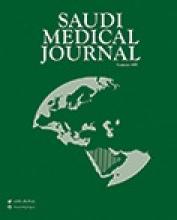To the Editor
I have read with interest the article by Zhang et al.1 Scientifically, abdominal binders though frequently used following laparotomy by many surgeons all over the world, with French surgeons specifically being very fond of them in the false belief that they protect the laparotomy wound from wound dehiscence, incisional hernia formation, seromas, and hematomas; there in no past or current scientific evidence to support this belief.2 Regarding the effect of abdominal binders following laparotomy on post-operative abdominal pain; the paper of rothman et al,3 concluded that this is unclear and is still largely uninvestigated. It is evident that the use of abdominal binders following laparotomy is more a matter of habit rather than scientific evidence.2 Scientific evidence of their usefulness is limited. Looking into the medical literature, only 4 trials on the use of abdominal binders following laparotomy have been published,2 all with a small number of patients. There are no data supporting the false belief that the use of abdominal binders following laparotomy prevent abdominal wall complications.2 In addition to the lack of scientific evidence of any significant benefit of abdominal binders following laparotomy except for psychological support; they carry many significant adverse effects listed in the article of Zhang et al:1 1) limitation of abdominal compliance, which may lead to increased intra-abdominal pressure (IAP), thus increasing the risk of intra-abdominal hypertension (IAH), and even abdominal compartment syndrome.4 If this happens, the condition of the patient will deteriorate, and the prognosis will worsen. Such IAH will result in increased intra-thoracic pressure, and even intra-cranial pressure, and thus respiratory and nervous system dysfunction. Also, increased IAP causing vascular compression may end in renal ischaemia, and increased cardiac preload further damaging physiological function;5 2) oesophageal partial hiatus hernia, and short segment acid reflux caused by increased IAP may contribute to the occurrence of oesophago-gastric junction adenoma in patients without acid reflux symptoms;6 3) a spontaneous non-traumatic trans-diaphragmatic intercostal hernia.7 The long-term increase in IAP due to long term use of an abdominal binder can cause slimming and loosening of the diaphragm and intercostal muscles weakening their resistance to the rapidly increased pressure of the thoracic-abdominal cavity.
With the lack of any proved benefit of abominal binders following laparotomy except for psychological support, and with the list of their possible adverse effects listed in the paper by the authors, some of which as increased IAP and its consequences may worsen the prognosis and cause physiological dysfunction as confessed by the authors; why use an abdominal binder? who will use an abdominal binder?
Reply from the Author
We would like to thank Dr. Barnouti for his attention and sincere enthusiasm for this article. Bouvier et al,2 mainly answered the question “Why do the surgeons use abdominal binders?” This survey reflected surgeons’ clinical treatment habit and its derivation, but did not focus on “whether it is reasonable?”. It is reported that abdominal binders can alleviate postoperative pain and anxiety, and can help to improve abilities of out-of-bed mobilization. These researches help to justify “the benefit of abdominal binders”.8-10 Due to wide and long-term use of abdominal binders in clinical treatment, scholars pay inadequate attention on abdominal binders, leading to the awkward situation, such as small sample size of clinical study, and limited case-control study of different types of abdominal binders, as well as leaving many questions to be answered. The systemic review by Rothman et al2 also did not absolutely certify “the benefit of abdominal binders”,3 but also cannot be falsified. Under this circumstance, the authors consider that it is wise to prudently use and adjust strategy by updating evidence. In this study,1 the authors pointed out that current comparative studies of elastic and non-elastic abdominal binders lacked objective evidence regarding their advantages and disadvantages. Therefore, this study aims to clearly define the effects of different abdominal binder types on IAP, physiology, and clinical outcomes, and to find the binder type that has only a small effect on IAP, minimizes the possibility of IAH, assists in postoperative recovery, and provides guidance for future clinical work. Through this study, we find that elastic binders have relatively little effect on IAP and are more helpful at promoting postoperative recovery than non-elastic binders. Therefore, we recommend using elastic binders, which have relatively little effect on IAP and abdominal compliance. At the same time, we emphasize that while using abdominal binders, physical function, and IAP should be closely monitored to avoid iatrogenic injury. The use of abdominal binders should be avoided in patients with IAH. If a binder must be used, the application time should be minimal, and it is essential not to wrap the abdominal binder too tightly, and to closely monitor intra-vesical pressure and avoid other factors that can affect IAP, intra-abdominal volume, and abdominal compliance.
Every coin has 2 sides. The adverse effects of abdominal binders on the body should also be noted. This article listed some adverse events by abdominal binders, but due to the different material, binding method, binding duration, binding strength, and patient types, its aim is mainly to show the bad consequences of abdominal binders caused by neglect regulation.
We must admit that there are still many points need to be revealed on abdominal binder use. We will reveal the problems one by one in the following studies, and continuously improve the research ideas and methods.
Lian-Yang Zhang
Trauma Center State Key Laboratory of Trauma Chongqing China
- Copyright: © Saudi Medical Journal
This is an open-access article distributed under the terms of the Creative Commons Attribution-Noncommercial-Share Alike 3.0 Unported, which permits unrestricted use, distribution, and reproduction in any medium, provided the original work is properly cited.






